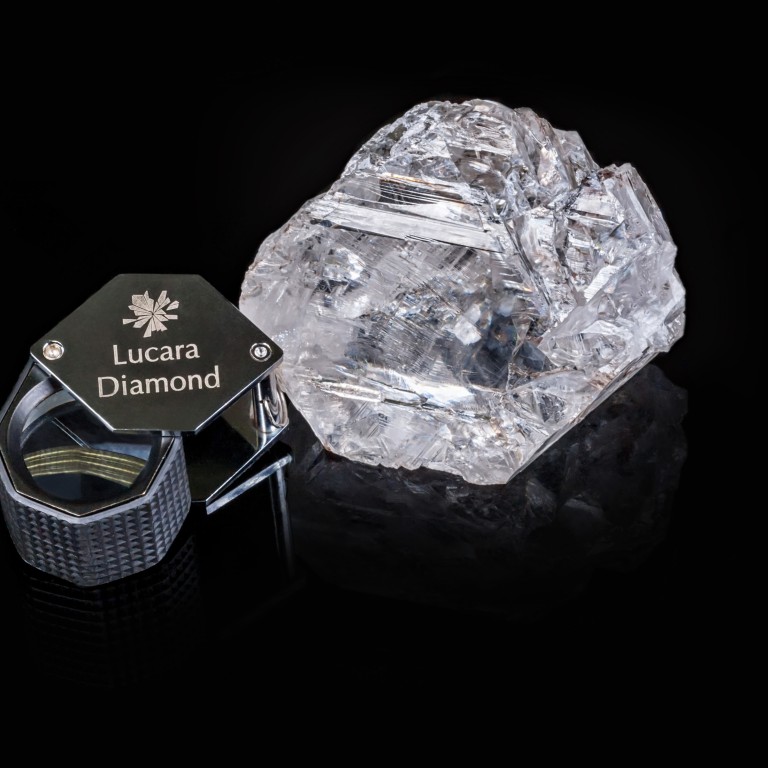
No sale for world’s second-largest diamond
US$68m bid not enough to meet the reserve price for Lucara’s 1,109-carat gemstone
Perhaps it was the Brexit jitters and currency devaluations still reverberating in London that gave some of the world’s wealthiest collectors attending Sotheby’s auction last week pause when the world’s second-largest diamond went up for auction.
Or maybe potential buyers don’t think bigger is necessarily better when it comes to gem quality.
Whatever the reason, the Lesedi La Rona, a 1,109-carat diamond, did not sell after the highest bid failed to meet the minimum reserve price that Vancouver’s Lucara Diamond Corp. had set for its tennis ball-sized rock.
When the diamond went up for auction on June 29, the bidding stopped at US$61 million, which did not meet Lucara’s reserve price, which was not disclosed.
Lucara CEO William Lamb pointed out that a 12 per cent buyer’s premium meant that the actual price that buyer would have paid would have been US$68.3 million.
“So somebody was actually willing to put US$68.3 million on the table for the diamond,” Lamb said.
Even at that price – which would have been a world record – it wasn’t enough for Lucara to let the stone go.
Lucara’s shares were briefly halted June 29. After the diamond failed to sell and trading resumed, Lucara’s shares dropped 14.5 per cent, closing at C$3.35 (US$2.60) per share, erasing half the value it gained on November 18, 2015, when the company shares shot up by 30 per cent after it announced its historic find.
Lucara’s shares recovered 4 per cent to US$3.48 (US$2.70) on June 30.
Lamb isn’t sure whether the uncertainty over the U.K.’s vote last week to leave the European Union might have given some potential collectors second thoughts about making such a large investment.
“I think it’s too difficult to say with a high level of certainty that Brexit was the reason why it didn’t sell,” Lamb said. “There may be certain components which have allowed increased volatility in the global economic market.”
Russell Shor, senior industry analyst for the Gemological Institute of America Inc., said currency devaluations from Brexit might have had some impact on potential buyers, depending on what country they are from. Someone paying in British pounds, for example, would be paying a 10 per cent exchange rate difference against the U.S. dollar.
But Shor also said the Lesedi La Rona might not be as high quality as the 813-carat stone that Lucara sold in May for US$63 million.
Shor stressed that he has not examined the stone himself, but said it appears from video of the stone that there may be some internal “stresses” that could pose challenges, should the buyer intend to cut and polish it.
“They had some videos of it, and it looks like there’s some cracks in the stone or some kind of internal stresses, which could prevent from cutting an extremely large or record-sized large diamond from it,” Shor said. “But I can’t say that authoritatively because I didn’t hold the stone and look at it.
“And apparently, from what I’ve heard from the people who did see both the 800 and 1,100, the 800 was better formed and clearer and slightly better colour.”
Lamb isn’t worried about eventually finding a buyer for the diamond.
“It was interesting,” he said. “The auction ended, and there was a bit of stunned silence for a couple of seconds and I stood up and, literally within 40 seconds, I had somebody standing next to me going, ‘We need to talk.’ Since then, we’ve actually had a number of emails and text messages saying, ‘Could you give me a call?’
“Giving the reserve price actually just allows people to see where our expectations were. This is not the end of the saga.”
Selling the Lesedi La Rona isn’t necessarily a financial imperative for Lucara. The company’s Karowe mine in Botswana has produced 47 stones weighing 100 carats or more over a three-year period, including the 813-carat Constellation that sold for US$63.1 million.
In May, Lucara reported first-quarter revenue of C$50.6 million (US$39.3 million) and cash on hand of C$144 million (US$111.7 million). Those earnings don’t include profits from the sale of the Constellation diamond.
“Lucara is not desperate to sell it,” Lamb said. “We have an exceptionally strong balance sheet, we have no debt, so we can actually take it slow. Let’s not react in an irrational way and choose the very first person that makes an offer.”
If the price the Constellation is used as a benchmark, the potential value of the Lesedi La Rona (US$77,490 per carat) could be in the US$86 million range, not counting the premium that might come from its historic value as the world’s second-largest diamond. (The largest was the 3,106-carat Cullinan diamond.)
But Shor isn’t sure that’s a proper benchmark, since the Constellation’s price far exceeded expectations.
“That 800-carat sold way above its estimate,” he said.
The value of the diamond would increase, if whomever buys it decides to cut and polish it. Lamb said he hopes whomever ends up owning the stone will buy it for its historic significance and not cut it.
“The optionality which the stone holds as a rough stone is multiple solutions and once you polish it, all of that is gone,” Lamb said.

